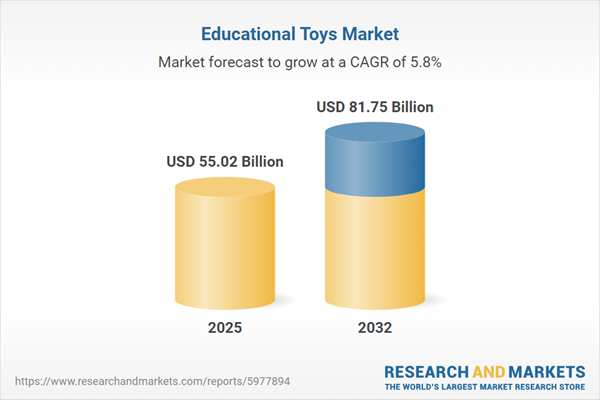Speak directly to the analyst to clarify any post sales queries you may have.
The educational toys market is evolving rapidly as technology integration, new regulations, and sustainability mandates reshape organizational priorities. Senior executives must navigate innovation, regulatory compliance, and operational flexibility to stay competitive in a complex landscape.
Market Snapshot: Educational Toys Market Trends and Growth
The global educational toys market reached USD 51.99 billion in 2024, with projections rising to USD 55.02 billion for 2025 and USD 81.75 billion by 2032. The compound annual growth rate stands at 5.82%. This momentum results from higher adoption of learning-through-play methodologies and the expanded digitalization of educational content. Major companies are investing in new technologies and supply chain efficiency, adapting to evolving regulatory environments and ensuring market compliance. Digital enhancements and agile logistics underpin efforts to address shifting customer demands and regulatory dynamics across the educational toys sector.
Scope & Segmentation in the Educational Toys Market
This report delivers actionable insights for executive leadership, providing a foundation for successful market entry, portfolio optimization, and regional growth strategies. The segmentation framework enables a detailed understanding of operational opportunities across channels, demographics, and regulatory environments. Key areas include:
- Product Types: Building sets, STEM kits, electronic learning aids, interactive action figures, puzzles, and themed dolls facilitate curriculum objectives and promote creative, guided play. Tailoring products by type helps organizations target specific skill sets and align with diverse educational standards.
- Age Groups: Educational toys span from infancy to teen years, supporting cognitive, social, and emotional growth. Age-relevant options enable effective skill progression and broaden the accessible customer base.
- Distribution Channels: Key channels include mass merchandisers, e-commerce platforms, educational specialty stores, supermarkets, and digital-only outlets. Multiple distribution paths increase accessibility and reinforce consumer relationships at every stage of the sales cycle.
- Price Range: Ranges include both value-focused and premium product lines, giving businesses flexibility to address various buyer segments and maximize reach according to market trends and consumer expectations.
- Regions Covered: Core geographies are the Americas, Europe, Middle East & Africa, and Asia-Pacific. Each region presents distinct educational regulations, procurement needs, and supply chain considerations, necessitating product and distribution adaptation.
- Leading Companies: Notable industry players shaping this sector include LEGO System A/S, VTech Holdings Limited, Mattel, Hasbro, Bandai Namco, Ravensburger, Spin Master, TOMY, Hape International, and Learning Resources. These companies establish product standards and drive industry-wide trends.
- Technologies and Trends: Innovation drivers such as augmented reality, artificial intelligence, adaptive learning technologies, eco-friendly materials, and circular economy models influence product development and compliance with international sustainability guidelines.
Key Takeaways for Senior Decision-Makers
- Adopting digital and interactive features increases engagement, ensuring continuous adaptation and clear market differentiation as learning methods advance.
- Deploying artificial intelligence and adaptive learning technologies offers tailored user experiences and promotes loyalty from educators and end-users.
- Streamlined product portfolios based on unified design principles enhance organizational agility, helping address evolving consumer needs across all age categories.
- Refined segmentation based on age, distribution channel, and region lays a strong groundwork for targeted business development and focused go-to-market strategies.
- Incorporating sustainable materials and responsible procurement supports compliance with international standards and positions organizations for continued leadership in sustainable solutions.
Tariff Impact: Navigating Policy Shifts and Ensuring Supply Chain Resilience
Recent U.S. tariff changes have driven manufacturers to reconsider supply chain structures, heightening the importance of local production. Senior leadership is encouraged to adopt real-time trade monitoring and cost management strategies, allowing effective responses to new trade rules and the evolving market environment. This adaptability safeguards value streams and enables identification of new growth opportunities as tariffs and regulatory landscapes change.
Methodology & Data Sources
This analysis draws on primary and secondary research, including industry data, regulatory filings, patent records, and expert interviews. Cross-validation ensures that guidance is practical and accurate for executives aiming to strengthen their position within the educational toys sector.
Why This Report Matters: Actionable Insights for the Educational Toys Sector
- Helps leadership anticipate compliance risks and exploit opportunities presented by shifting regulations and emerging technologies.
- Provides robust, validated intelligence to support procurement, compliance, and innovation initiatives, ensuring competitive strength in sustainable growth.
- Reinforces effective sourcing and product development, enhancing the organization’s ability to build and maintain market leadership.
Conclusion
This report provides senior executives with strategic guidance to navigate change and seize opportunities in the educational toys industry. Emphasizing technology incorporation and agile sourcing will be vital to sustaining future competitive advantage.
Additional Product Information:
- Purchase of this report includes 1 year online access with quarterly updates.
- This report can be updated on request. Please contact our Customer Experience team using the Ask a Question widget on our website.
Table of Contents
3. Executive Summary
4. Market Overview
7. Cumulative Impact of Artificial Intelligence 2025
Companies Mentioned
The companies profiled in this Educational Toys market report include:- LEGO System A/S
- VTech Holdings Limited
- Mattel, Inc.
- Hasbro, Inc.
- Bandai Namco Holdings Inc.
- Ravensburger AG
- Spin Master Corp.
- TOMY Company, Ltd.
- Hape International AG
- Learning Resources, LLC
Table Information
| Report Attribute | Details |
|---|---|
| No. of Pages | 190 |
| Published | October 2025 |
| Forecast Period | 2025 - 2032 |
| Estimated Market Value ( USD | $ 55.02 Billion |
| Forecasted Market Value ( USD | $ 81.75 Billion |
| Compound Annual Growth Rate | 5.8% |
| Regions Covered | Global |
| No. of Companies Mentioned | 11 |









